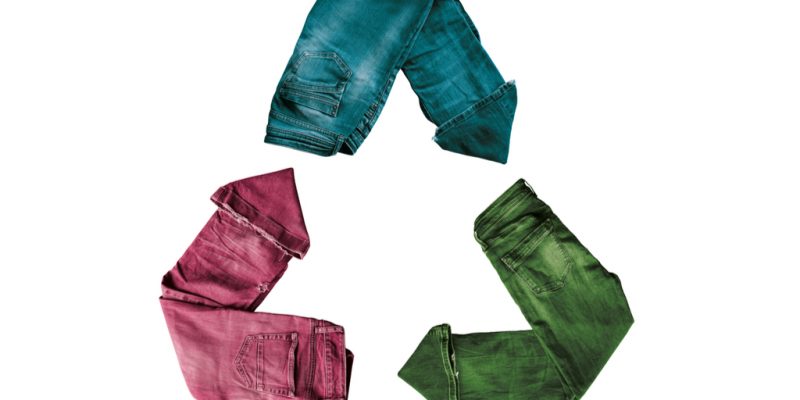It seems that green is very in vogue this season – or at least, for the University of Leeds, which has become the first university to sign an agreement centred on sustainability in the fashion industry. The issue of waste is rampant in the fashion world, with approximately 10,000 items of clothing being sent to landfill every five minutes and millions of gallons of water wasted every year. To make a single pair of jeans, a staggering 1,800 gallons of water is used, and the value of clothing wasted equates to around £140 million every year.
While it’s important to each do our best to be more environmentally friendly, without a fundamental change in the fashion industry, progress towards sustainability will be impossible. Enter Textiles 2030, a new initiative aimed at decreasing negative environmental impact of clothing companies around the world. This initiative has been backed by the UK government, and companies such as John Lewis, Primark, Sainsbury’s and Marks & Spencer have all signed the agreement. Textiles 2030 is a voluntary agreement to ensure products are made sustainably, with a longer lifespan and can be re-used or recycled, to reduce the environmental footprint of the fashion industry.
Inspired by research showing increasing public demand for sustainable fashion, Textiles 2030 rejects the UK’s current produce-wear-dispose fashion culture promoted by fast fashion companies and aims to weed out the root of the problem: the companies themselves. It is led by the international non-government organisation WRAP, which works alongside governments, companies and independent small businesses to ensure sustainable use of the Earth’s natural resources. The objective is to reduce the carbon footprint and water usage of the fashion and textiles industry, in line with the 2016 UN Paris Agreement on limiting climate change.

For some insider insight into the Textiles 2030 initiative, we interviewed the University of Leeds’ Dr Mark Sumner, who is a lecturer in Sustainability, Fashion and Retail in the School of Design and a member of the Textiles 2030 advisory board. Here’s what he had to say…
Do you believe that the Textiles 2030 initiative will work?
The Textiles 2030 agreement is an extension of the SCAP (Sustainable Clothing Action Plan) 2020 agreement, which had certain targets laid down for carbon, water and waste reductions. As part of that agreement, the industry was able to hit this target and actually do significantly better than most targets, in terms of reducing carbon and water consumption for the industry. With SCAP, we can see that there’s a custom that has been set in terms of the industry and its stakeholders working at delivering those environmental targets. They are very difficult targets, but there is evidence to suggest that the industry can work together to deliver these targets.
But it isn’t just about these targets, the initiative is also about how the industry can work together to deliver best practice and promote good working practices around how the industry operates. It’s also about how the industry can work with a supply chain and how we can influence and help consumers to make the right decisions. Working with SCAP, there were areas of really interesting success that we can build on. The Textiles 2030 targets and aspirations are very high, so with the contributions from the University of Leeds, the expertise that we have within the School of Design and other people and consumers, we can support the industry in its progress.
Could you explain a little bit about the targets – I read something about reducing net waste?
I think what you’re talking about there is a carbon reduction. The target is a 50% reduction in carbon, based on a bassline which provisionally is talking about 2019. So, this is the idea of saying ‘what’s the carbon footprint from the industry in 2019?’ and the target for 2030 is to get that down by 50%. This is in line with achieving the 1.5-degree global warming target.
What is net zero?
Net Zero is around climate change, and it’s where we end up in a position where our activities don’t release any additional carbon into the atmosphere.
What will this initiative mean for students? Will it make clothing more expensive?
When we look at the market surveys about people’s attitudes to sustainability, lots of people say that they are willing to pay more for products that are demonstrated to be green. So, potentially even if things do become more expensive, market research tells us that students would be willing to pay more. However, the market research doesn’t represent actual behaviour, so that is a bit of a curveball. We’ve got data that shows being green doesn’t necessarily mean that things will be more expensive – I would actually argue that, in many cases, fast fashion brands are doing interesting things around sustainability that is not having an impact on the price that you see as the consumer.
But I think what this initiative does mean is that people who want to engage in sustainability and have a greener wardrobe are going to have to do a bit more work in terms of research. They need to start thinking: ‘Who am I buying from? What are those brands doing? Are they part of the Textiles 2030 agreement and what level of work have they done or what progress have they made?’ If students really want to engage in being greener in their clothing choices, they will have to do some research. This is actually important for individual decisions.
“It’s fine to say that you’re a sustainability activist and to post things on your social media, but you’re only going to make a change to the environment and the sustainability movement by realigning your behaviour with greener activities.”
It may be that you actually have to stop buying from certain organisations, based on the research you do, and actually shop with others. The evidence also tells us that students potentially need to start thinking about how much fashion they’re buying. I’m not saying that you shouldn’t buy stuff – but it’s about making a conscious decision about why you are buying things. The aftercare of garments and the amount you wash and wear it all have an impact on the sustainability of a garment. Also, what you do with that garment when you finish with it is really important.
Some data from a few years ago surrounding the activity of Leeds students done by the University’s sustainability team found that at the end of each academic year, there was an increase in nearly 350 tonnes of extra waste that was going into the Leeds city waste collection system. This stuff that was essentially going into landfill and a very large portion of that stuff was coming from student homes as they cleared out at the end of the year. So, what I hope this initiative will mean for students is that they have the opportunity to learn more about the fashion industry and what brands are doing to be greener, but I hope it also means they learn more about what they can do to change their behaviour. It’s only when people change their behaviour will we be able to be anywhere near to meeting the challenges of climate change and sustainability.

And what would you recommend we do with clothes once we finish them? Recycle them? Charity shops?
The most important thing to do is to avoid that product going into landfill. Once it goes into landfill, it’s lost from the system. With most clothing that we see in the UK, it can be reused by someone or some organisation. People might want to sell it on Depop or on Ebay, they might want to give it to charity or make use of the Take Back schemes that a number of brands are offering. The important thing is to make sure that that garment doesn’t go to landfill. Some garments that can’t go back to brands or be given charities, like underwear or garments that have really been worn to the end of their life. But for those garments that can be reused, we need to be thinking about how we get those into a reuse chain.
What brand would you personally recommend?
Dr. Sumner was unable to recommend any brand personally, due to his role as a consultant, but he did say this:
Sustainability is a very diverse area and different people have different definitions. Companies are doing some interesting things right now around climate change, water use, worker rights and pay, and animal welfare. For your readers, they need to do their own research to find out which brand they most align with in terms of sustainability. There is a lot of misinformation surrounding fast fashion brands, with all fast fashion brands being treated in the same way and seen as unethical, I would argue that that is very contradictory to the reality. Some fast fashion brands might not be doing what they should do, but many of the fast fashion brands are leading the charge on this approach to sustainability. It’s actually many of the designer brands that are falling behind.
If you find that the brand that you most commonly buy from appears to be doing nothing, get in touch with the brand. Challenge them. And I mean get in touch with them – I don’t mean post on social media, actually write to their customer service. If you’re really passionate, and you really want to make things happen, get in touch with the chief executive. Ask them what they’re doing and why they aren’t part of 2030 and these initiatives. Activism is more than posting on social media. Pro-active activism is more likely to get brands to listen to what students are saying.
It should be noted that Gym Shark, ASOS, Boohoo, New Look, Missguided and Urban Outfitters have all signed with Textiles 2030.
Is there a way for companies to be sustainable and ethical while maintaining affordable costs?
Yes – the brands and retailers that are really serious about this have been working very hard for a number of years to work out how to deliver a sustainable fashion clothing option to their consumers. Because they’ve been working on this for so long, they’ve worked out a way of delivering fashion that is sustainable, but also desirable and good value for money to the consumer. It does take a lot of hard work from the brands – a brand can’t suddenly become sustainable with no one consulted. A lot of brands that are signing up to Textiles 2030 are brands that have been working on this for many years. As a result of all of that hard work, they are now able to offer products that you want to buy, functional products that are fashionable, durable and sustainable. There’s still a long way to go – we’ve got to do more and we’ve got to do it fast. That’s why the 2030 targets are so aspirational, because it goes beyond just carbon and water and waste – it really extends the challenge the industry has got.
So, next time as you’re online, browsing for killer post-COVID fits, remember to stop and think – is it sustainable? Will you actually wear it? Is the company ethical? Because feeling good is just as important than looking good, and what’s better than looking after our planet?
Happy shopping, everyone!

